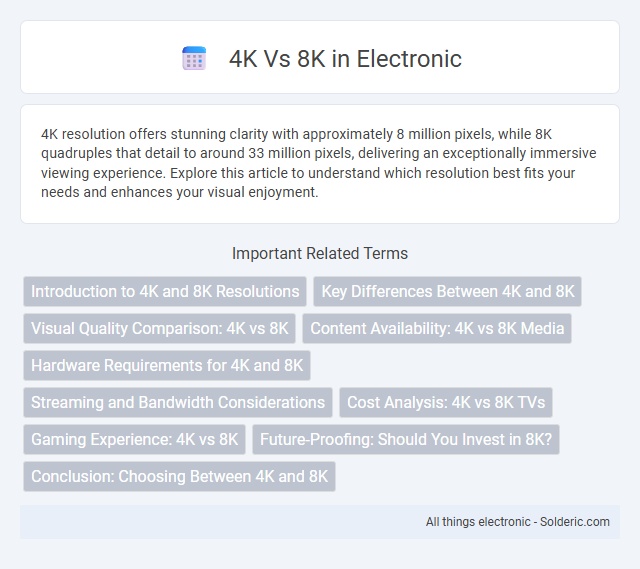4K resolution offers stunning clarity with approximately 8 million pixels, while 8K quadruples that detail to around 33 million pixels, delivering an exceptionally immersive viewing experience. Explore this article to understand which resolution best fits your needs and enhances your visual enjoyment.
Comparison Table
| Feature | 4K Resolution | 8K Resolution |
|---|---|---|
| Pixels | 3840 x 2160 (8.3 million pixels) | 7680 x 4320 (33.2 million pixels) |
| Image Detail | Ultra HD with sharp clarity | Four times sharper than 4K, extreme detail |
| Recommended Screen Size | 40" to 65" | 65" and above |
| Bandwidth Requirements | 25 Mbps for streaming | 50 Mbps or higher for streaming |
| Content Availability | Widely available on streaming and Blu-ray | Limited but growing |
| Price Range | Affordable to mid-range | Premium pricing |
| Use Cases | Home theater, gaming, general media | Professional media, future-proofing, high-end viewing |
Introduction to 4K and 8K Resolutions
4K resolution, also known as Ultra HD, offers a pixel count of approximately 3840 x 2160, delivering four times the detail of Full HD (1080p). 8K resolution doubles this, with a pixel count of 7680 x 4320, providing sixteen times the detail of 1080p and four times that of 4K. The higher pixel density in 8K enables sharper images and finer details, particularly noticeable on larger screens and in professional applications like film and medical imaging.
Key Differences Between 4K and 8K
4K resolution features approximately 8.3 million pixels with a display size of 3840 x 2160, offering sharp and detailed images ideal for most modern TVs and monitors. 8K resolution quadruples this pixel count to about 33.2 million pixels at 7680 x 4320, delivering incredibly finer detail suitable for large screens and professional use. Your viewing experience improves significantly with 8K when close to very large displays, although 4K remains the practical choice for everyday content due to wider availability and lower hardware demands.
Visual Quality Comparison: 4K vs 8K
8K resolution offers four times the pixel count of 4K, delivering significantly sharper and more detailed images, especially on larger screens or when viewed up close. Enhanced color depth and improved dynamic range in 8K contribute to richer visuals and more lifelike scenes. The increased pixel density reduces visible pixelation, providing a smoother and more immersive viewing experience compared to 4K.
Content Availability: 4K vs 8K Media
4K content is widely available across streaming platforms, broadcast channels, and Blu-ray discs, making it accessible for most consumers. In contrast, 8K media is still limited, with few native titles and minimal streaming support due to high bandwidth requirements. The scarcity of 8K content hinders its adoption despite the superior resolution.
Hardware Requirements for 4K and 8K
4K and 8K resolutions demand significantly different hardware capabilities, with 8K requiring substantially more powerful processors, graphics cards, and higher bandwidth for video playback and streaming. 8K displays demand advanced HDMI 2.1 interfaces and enhanced GPU performance to handle the 33.2 million pixels, compared to 8.3 million pixels in 4K. Storage and memory requirements also increase exponentially for 8K content due to larger file sizes and higher data throughput, making 8K setups more resource-intensive and costly.
Streaming and Bandwidth Considerations
Streaming 8K content demands significantly higher bandwidth than 4K, often requiring at least 50 Mbps compared to 15-25 Mbps for 4K streaming. Your internet connection and data caps must support these speeds to avoid buffering and quality drops. Efficient compression technologies like AV1 help reduce bandwidth usage but 8K streaming remains more challenging for most home networks.
Cost Analysis: 4K vs 8K TVs
The cost difference between 4K and 8K TVs remains significant, with 8K models priced substantially higher due to advanced technology and limited market availability. 4K TVs offer a more affordable option while delivering excellent picture quality that meets most consumer needs, making them the pragmatic choice for budget-conscious buyers. Your investment in 8K may not provide proportional value currently, as 8K content and compatible devices are still scarce, impacting overall cost-effectiveness.
Gaming Experience: 4K vs 8K
Gaming at 4K resolution delivers sharp, detailed visuals with strong performance on most current systems, making it the preferred choice for smooth gameplay and high frame rates. 8K gaming offers unparalleled image clarity and immersion but requires extreme GPU power, often limiting frame rates and increasing hardware demands. You should weigh your system's capabilities and gaming priorities when choosing between 4K's balance of performance and quality versus the ultra-high resolution of 8K.
Future-Proofing: Should You Invest in 8K?
Investing in 8K technology offers superior future-proofing with resolution four times higher than 4K, ensuring compatibility with upcoming ultra-high-definition content and streaming services. As 8K panels become more affordable and content creation ramps up, purchasing 8K now can provide long-term value despite limited current availability. Opting for 8K also aligns with advancements in HDMI 2.1 and enhanced color accuracy, positioning it as a smart choice for tech enthusiasts and early adopters.
Conclusion: Choosing Between 4K and 8K
Choosing between 4K and 8K depends on viewing distance, screen size, and content availability, with 4K providing excellent clarity for most users at standard viewing distances. 8K offers superior resolution and detail, ideal for large screens and close-up viewing, but currently has limited content and higher costs. For practical purposes, 4K remains the more accessible and cost-effective option while 8K suits enthusiasts seeking the latest technology and future-proofing.
4K vs 8K Infographic

 solderic.com
solderic.com